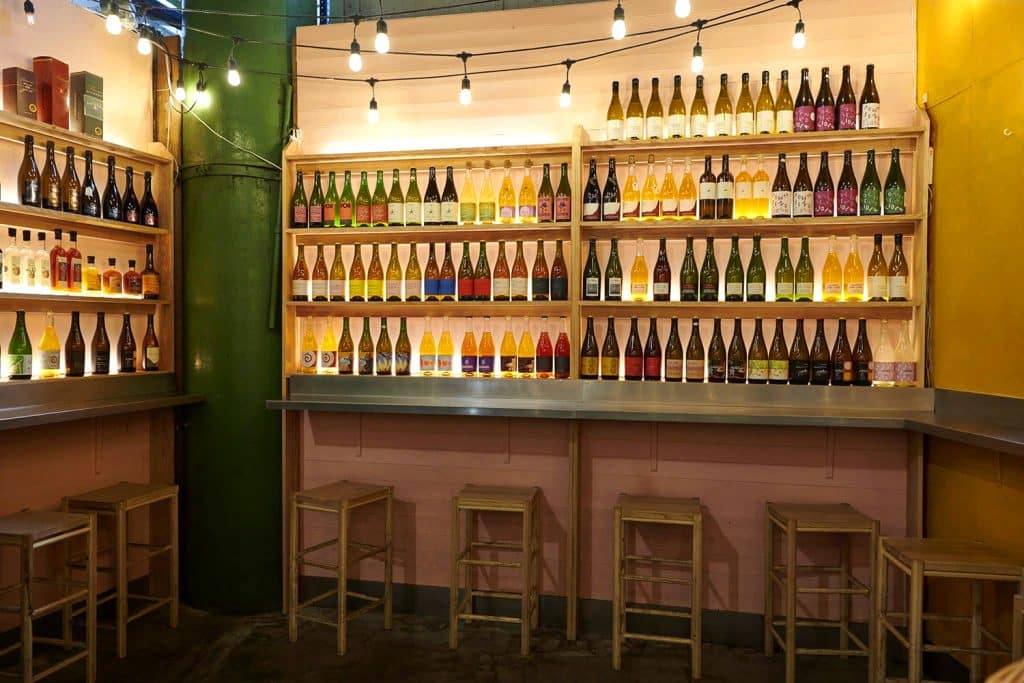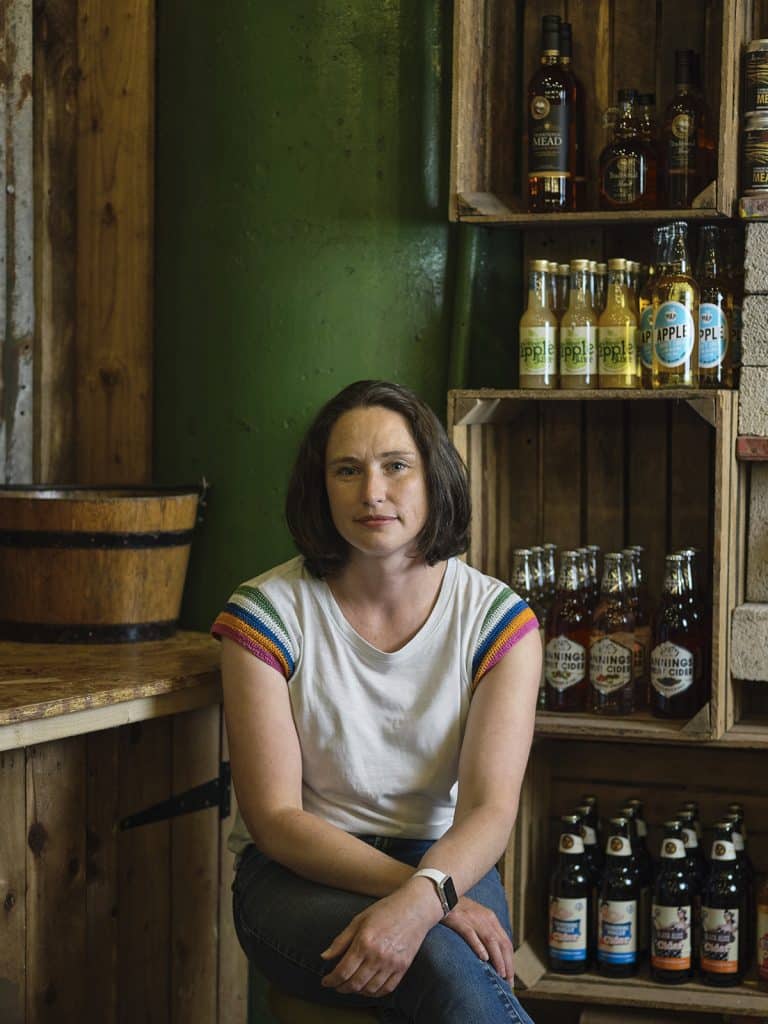In cider trading
Tomé Morrissy-Swan visits The London Cider House to discover how the fading art of cider making has enjoyed a very welcome renaissance


“THERE’S SUCH A BREADTH OF VARIATION: DON’T THINK THAT IF YOU’VE TRIED ONE CIDER YOU’VE TRIED THEM ALL”
Words: Tomé Morrissy-Swan / Portrait: Orlando Gili
When New Forest Cider started selling cider at Borough Market 25 years ago, it was a very different world. To most, the drink connoted two-litre plastic bottles of cheap white cider, underage drinking and getting blasted at festivals. “It was cans of very cheap, nasty commercial ciders, which really don’t have many apples in them at all,” says Mary Topp.
Over the past two decades that has changed. In the mid-noughties Irish brand Magners conquered the British market but, alongside that, a cohort of smaller artisan producers were growing more confident. New Forest Cider, based near Burley in Hampshire, was one of the key drivers of this renaissance. It was founded in 1988 by Mary’s father, Barry Topp, who inherited a smallholding with an orchard, quickly bought some pressing equipment and was soon making cider on a commercial scale, mostly with apples from Somerset and Herefordshire.

I’m talking to Mary at The London Cider House, a bar and shop within Borough Market owned by cider makers Ted Dwane, Tom Oliver and the Topps, as well as Felix Nash of The Fine Cider Company. The aesthetic is more akin to a modern wine shop and bar – elegant bar seating; bottles with prices scribbled in white marker lining the walls – than a pub with a barrel of scrumpy out the back. But the cider Mary pours me is inspired by scrumpy. “We have quite negative connotations of scrumpy, of backyard cider,” Mary explains. “However, we like to think ours now is a more grown-up sister of the nostalgic scrumpy of days gone by. It’s traditional scrumpy in a sense, containing 100 per cent apple juice, but this one in particular is a lightly sparkling cider.” It’s beautifully sweet with a nice, balanced acidity, a delicate fizz, and not too rough around the edges. It has been pasteurised, filtered, kegged and carbonated. “It’s a little bit cleaner than a traditional cloudy scrumpy,” adds Mary.
In the 1990s there wasn’t as much artisan cider as today – although you could find it at farm shops and many West Country pubs. Barry Topp spent hours driving up and down the country to fairs, but always wanted a London location to showcase his product. He ran a stall at the Food Lovers’ Fair of 1998 (which led to Borough Market in its modern form) and has run one here, in various guises, ever since.
Mary came on board in 2008, when the shop was still called New Forest Cider (it would later be renamed The Cider House, before changing again when it reopened after Covid under the current ownership). “Around 2010 there was a real boom in cider,” Mary explains. “This was post-Magners, they’d done a lot of marketing, and everyone was getting interested in cider.” That included many up-and-coming producers, who Mary wanted to showcase, and the shop soon sold ciders from across the country.
As with wine, there are myriad regional and varietal differences in cider. A key one is the split between east and west. In eastern counties like Kent, Sussex and Suffolk, cider is made mostly with culinary fruits, and is more acid-driven, according to Mary. In the west, cider fruits reign. They are smaller, have tougher skins and are more bitter, not great to eat. They produce more tannic ciders. Mary recommends Gospel Green, based in Hampshire, as one of her favourite eastern-style ciders. Of the western-style ciders, Pilton is one of the bestsellers at The London Cider House. Its ‘keeved’ ciders – a traditional method of enhancing the natural sweetness of the fruit – are a great introduction, says Mary.
Most Brits are unaware of the huge variety of ciders produced in this country. It can be still, sparkling, dry or sweet, distilled or fortified, made in a similar way to a pet nat wine, or bottled and fermented using the Champagne or Normandy methods. “It’s like the wine industry, there’s such a breadth of variation,” says Mary. “Don’t think that if you’ve tried one cider you’ve tried them all.”

One of The London Cider House’s owners is Tom Oliver, a man who has emerged as a leading cider maker over the past 25 years. Oliver started selling cider made on his family’s farm in 1998, when it ceased hop production. Today, he makes 100,000 litres per year, mostly using apples from nearby farms in Herefordshire, which he describes as the “perfect area for growing cider fruit.” When Tom began making cider there were around 12 makers in the county. He has helped it go from a “cheap product” to a valued drink, and there are now around 50 in Herefordshire.
“When I started making cider, it was pretty much based around dry, medium and sweet, maybe a sparkling,” says Tom. “That’s how people thought about cider.” For him, the craft beer explosion of the noughties piqued people’s tastebuds and encouraged them to seek out a wider range of drinks. Oliver makes 36 different bottled products, from blends rather than single varietals. Gold Rush, a barrel-aged, medium-dry cider, is one of his bestsellers, and each year’s drink tastes slightly different. His lush, sweet keeved perry is another popular choice. A slower seller is his Vintage, a dry, still cider. “That’s my type of cider,” he beams.
Artisan cider remains a niche, consumed by a tiny minority. “That’s one of the things we’re working on,” says Tom. Part of that drive is to boost its appeal as a food accompaniment. At The London Cider House, most come in 750ml bottles, which connotes an aperitif, or something to sip alongside a meal, rather than to simply get drunk. Mary recommends cider before a meal, or with starters like mussels. For Tom, it’s great with cheese (especially cheddar), a Christmas ham or even one of our national dishes. “A medium sparkling cider with a spicy medium-hot curry is the best drink.”
Britain drinks the highest volume of cider in the world, “but it’s not ingrained in our culture,” Tom laments. “Some people enjoy cider and a roast lunch on Sunday, but we haven’t got any longstanding food associations.” For the owners of The London Cider House, it’s high time that changed.


